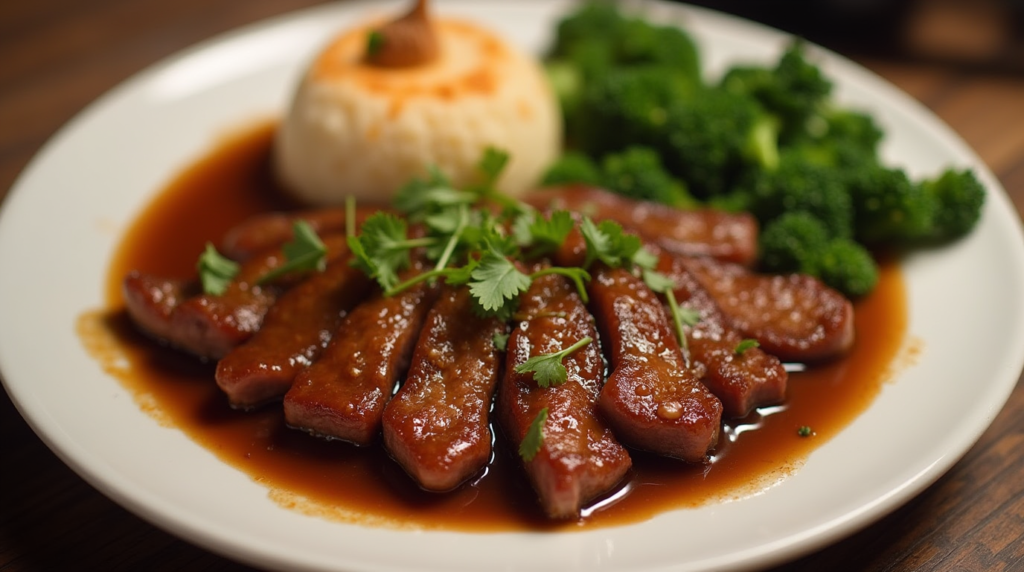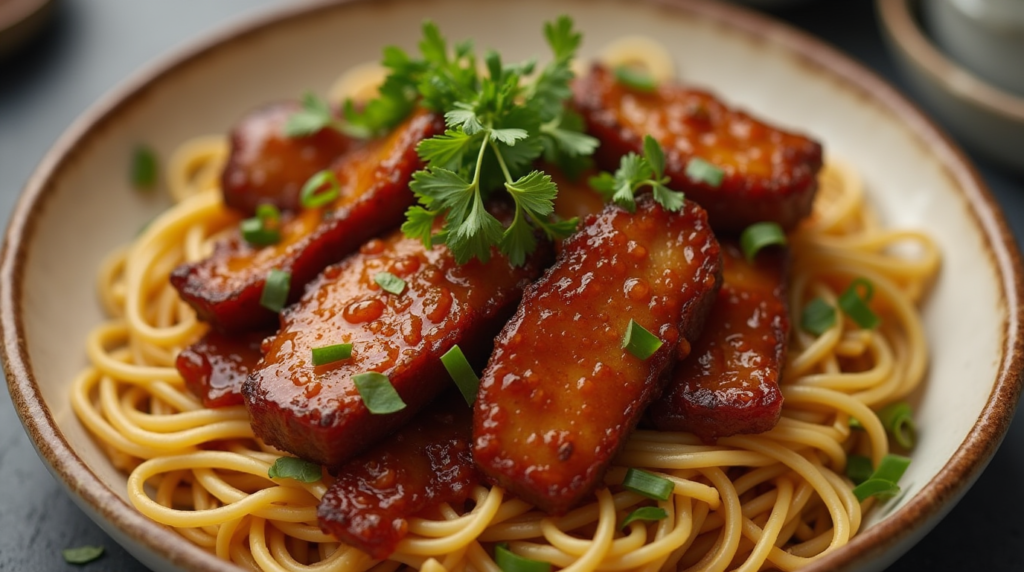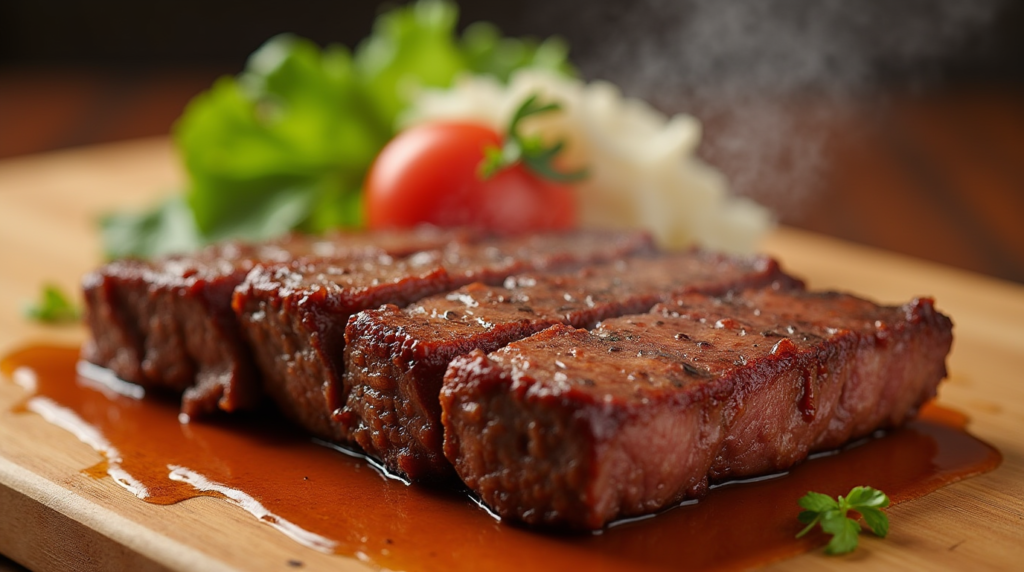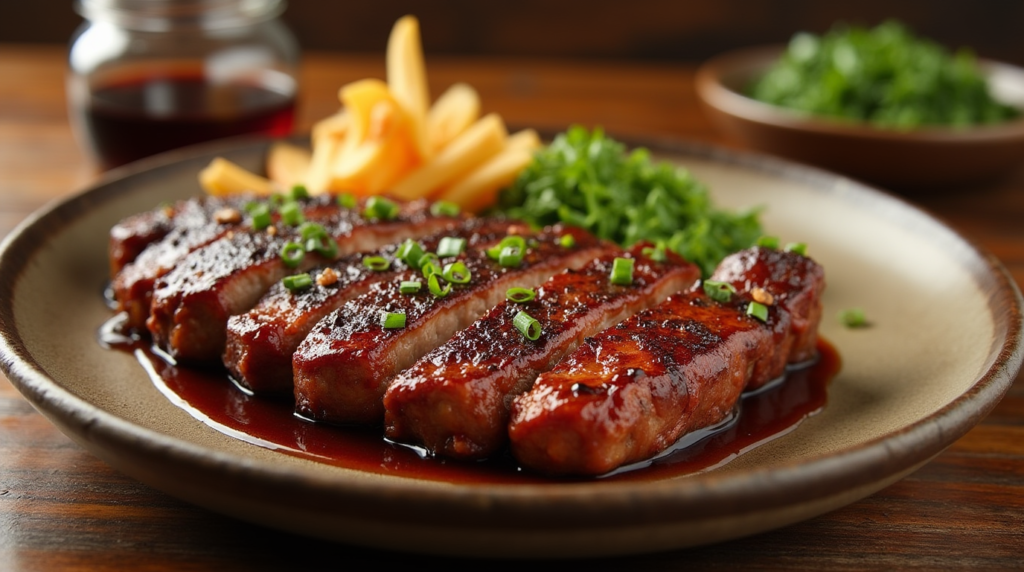Introduction: Why Bulgogi Porc Will Become Your New Favorite Dish

Imagine the sizzle of tender pork slices caramelizing on a hot grill, the aroma of garlic, ginger, and soy sauce wafting through the air, and the first bite that bursts with sweet, savory, and smoky flavors. That’s the magic of Bulgogi Porc, a Korean-inspired dish that’s as delightful to make as it is to eat. Whether you’re a seasoned home cook or a beginner exploring Korean cuisine, this guide will help you master the art of Bulgogi Porc. By the end, you’ll not only have a delicious meal but also a deeper appreciation for the rich culinary traditions behind it. Let’s dive in!
What is Bulgogi Porc?
The Origins of Bulgogi in Korean Cuisine
- Bulgogi, meaning “fire meat,” has been a staple in Korean cuisine for centuries, traditionally made with beef.
- Pork became a popular alternative due to its affordability and versatility, giving rise to Bulgogi Porc.
- This dish reflects Korea’s culinary philosophy of balancing flavors: sweet, salty, spicy, and umami.
What Makes Bulgogi Porc Unique?
- Unlike beef bulgogi, pork absorbs the marinade more deeply, resulting in a richer flavor.
- The combination of soy sauce, garlic, and pear (or apple) creates a tenderizing effect, making the meat incredibly juicy.
- Its versatility allows it to be grilled, pan-fried, or even cooked on a BBQ, making it perfect for any occasion.
Why You’ll Love Bulgogi Porc
- It’s quick to prepare, with most of the time spent marinating.
- You can customize the flavors to suit your taste—spicy, sweet, or tangy.
- It’s a crowd-pleaser, ideal for family dinners, parties, or meal prep.
Essential Ingredients for Bulgogi Porc
The Perfect Cut of Pork for Bulgogi
- Recommended Cuts:
- Pork shoulder: Juicy and flavorful.
- Pork belly: Rich and tender.
- Pork tenderloin: Lean and quick-cooking.
- Tips for Slicing:
- Freeze the pork for 30 minutes to make slicing easier.
- Cut against the grain into thin, even slices for maximum tenderness.
The Bulgogi Marinade: Key Components
- Core Ingredients:
- Soy sauce: The base for umami flavor.
- Garlic and ginger: Adds depth and warmth.
- Sesame oil: Provides a nutty aroma.
- Brown sugar or honey: Balances the saltiness with sweetness.
- Pear or apple: Natural tenderizers that add a hint of fruitiness.
- Role of Each Ingredient:
- Soy sauce and sesame oil create the signature Korean flavor.
- Sugar and fruit help caramelize the meat during cooking.
Optional Add-Ins for Extra Flavor
- Gochujang (Korean chili paste): For a spicy kick.
- Rice wine or mirin: Enhances the marinade’s depth.
- Sesame seeds and green onions: Perfect for garnish and added texture.
How to Make Bulgogi Porc: Step-by-Step Guide
Preparing the Pork and Marinade
- Slice the Pork: Cut against the grain into thin, even slices.
- Mix the Marinade: Combine soy sauce, garlic, ginger, sesame oil, sugar, and grated pear in a bowl.
- Coat the Pork: Toss the pork slices in the marinade until fully coated.
Marinating Tips for Maximum Flavor
- Marinating Time: At least 2 hours, but overnight for the best results.
- Storage: Keep the marinated pork in an airtight container in the fridge.
- Pro Tip: Reserve a portion of the marinade (before adding raw meat) for basting while cooking.
Cooking Methods for Bulgogi Porc
- Grilling:
- Preheat the grill to medium-high heat.
- Cook the pork for 2-3 minutes per side until caramelized.
- Pan-Frying:
- Heat a skillet over medium-high heat.
- Cook the pork in batches to avoid overcrowding.
- BBQ:
- Perfect for outdoor gatherings.
- Use a grill basket to prevent small pieces from falling through.

Serving and Pairing Bulgogi Porc
Traditional Korean Side Dishes (Banchan)
- Kimchi: Fermented cabbage for a tangy crunch.
- Pickled Radishes: Refreshing and slightly sweet.
- Spinach Salad: Light and nutritious.
- Steamed Rice and Lettuce Wraps: Essential for a complete meal.
Modern Twists on Serving Bulgogi Porc
- Bulgogi Porc Tacos: Serve in tortillas with slaw and spicy mayo.
- Rice Bowls: Layer with rice, veggies, and a fried egg.
- Sliders: Perfect for parties or appetizers.
- Fusion Dishes: Try Bulgogi Porc pizza or pasta for a creative twist.
HBeverage Pairings for Bulgogi Porc
- Traditional Korean Drinks:
- Soju: A clear, slightly sweet liquor.
- Makgeolli: A milky rice wine.
- Non-Alcoholic Options:
- Iced barley tea: Light and refreshing.
- Citrus-infused water: Adds a zesty touch.
Tips and Tricks for Perfect Bulgogi Porc
Common Mistakes to Avoid
- Over-Marinating: Can make the meat mushy. Stick to 24 hours max.
- Using the Wrong Cut: Avoid overly lean cuts, as they can dry out.
- Slicing Too Thick: Thin slices ensure even cooking and better flavor absorption.
How to Store and Reheat Leftovers
- Storage: Keep in an airtight container in the fridge for up to 3 days.
- Reheating: Use a skillet over medium heat to retain texture and flavor.
Customizing Your Bulgogi Porc
- Adjust Flavors: Add more sugar for sweetness or gochujang for heat.
- Vegetarian/Vegan Options: Use tofu or mushrooms as a meat substitute.
*-Bulgogi Porc Recipe Table
| Ingredient | Quantity | Notes |
|---|---|---|
| Pork shoulder | 1.5 lbs | Thinly sliced against the grain |
| Soy sauce | 1/2 cup | Use low-sodium if preferred |
| Garlic | 4 cloves | Minced |
| Ginger | 1 tbsp | Grated |
| Sesame oil | 2 tbsp | For nutty aroma |
| Brown sugar | 3 tbsp | Can substitute with honey |
| Pear or apple | 1/2 cup | Grated for tenderizing |
| Green onions | 2-3 stalks | Chopped for garnish |
| Sesame seeds | 1 tbsp | For topping |
The Cultural Significance of Bulgogi in Korea
Bulgogi as a Symbol of Korean Hospitality
- In Korea, bulgogi is often served during special occasions, family gatherings, and celebrations.
- It’s a dish that symbolizes warmth, generosity, and togetherness.
- Sharing a bulgogi meal is a way to connect with loved ones and create lasting memories.
The Evolution of Bulgogi
- Originally, bulgogi was a luxury dish reserved for royalty during the Goguryeo era (37 BC–668 AD).
- Over time, it became a beloved street food and household staple.
- The introduction of pork as a main ingredient made it more accessible to the masses.
Bulgogi in Modern Korean Cuisine
- Today, bulgogi is a global phenomenon, with variations like Bulgogi Porc gaining popularity.
- It’s a staple in Korean BBQ restaurants worldwide, often served with an array of side dishes (banchan).
Health Benefits of Bulgogi Porc
Nutritional Value of Pork
- Pork is a great source of protein, essential for muscle repair and growth.
- It contains vitamins like B6 and B12, which support brain function and energy production.
- Lean cuts like pork tenderloin are low in fat and calories, making them a healthier choice.
Benefits of Bulgogi Marinade Ingredients
- Garlic and Ginger: Known for their anti-inflammatory and immune-boosting properties.
- Sesame Oil: Rich in antioxidants and healthy fats.
- Pear or Apple: Adds natural sweetness and aids digestion.
Tips for a Healthier Bulgogi Porc
- Use low-sodium soy sauce to reduce salt intake.
- Opt for lean cuts of pork and trim excess fat.
- Serve with plenty of fresh vegetables and whole grains for a balanced meal.

Regional Variations of Bulgogi Porc
Seoul-Style Bulgogi Porc
- Characterized by a sweeter marinade with a focus on caramelization.
- Often served with a side of ssamjang (spicy dipping sauce) and lettuce wraps.
Busan-Style Bulgogi Porc
- Features a spicier marinade, thanks to the addition of gochujang or red pepper flakes.
- Commonly served with seafood-based side dishes, reflecting Busan’s coastal cuisine.
Tools and Equipment for Making Bulgogi Porc
Essential Kitchen Tools
- Sharp Knife: For thinly slicing the pork.
- Mixing Bowls: For preparing the marinade.
- Grill or Skillet: For cooking the pork to perfection.
- Tongs: For flipping the meat while cooking.
Optional but Helpful Tools
- Meat Tenderizer: To ensure even thickness for uniform cooking.
- Grill Basket: For outdoor BBQ cooking, preventing small pieces from falling through the grates.
- Marinade Injector: For deeper flavor penetration in thicker cuts.
Bulgogi Porc for Special Diets
Gluten-Free Bulgogi Porc
- Substitute regular soy sauce with tamari or coconut aminos.
- Ensure all other ingredients, like gochujang, are gluten-free certified.
Low-Carb/Keto-Friendly Bulgogi Porc
- Replace brown sugar with a keto-friendly sweetener like erythritol or monk fruit.
- Serve with lettuce wraps instead of rice.
Vegetarian/Vegan Bulgogi Porc
- Use tofu, tempeh, or mushrooms as a meat substitute.
- Adjust the marinade to include extra umami ingredients like miso paste or nutritional yeast.
Bulgogi Porc Around the World
Popularity in the United States
- Bulgogi Porc is a favorite in Korean BBQ restaurants across the U.S.
- It’s often featured in food trucks and fusion cuisine.
Bulgogi Porc in Europe
- European chefs are incorporating Bulgogi Porc into fine dining menus.
- It’s gaining traction as a trendy dish in cities like London and Paris.
Bulgogi Porc in Asia
- In Japan, Bulgogi Porc is often served with rice bowls or ramen.
- In Southeast Asia, it’s paired with local flavors like lemongrass and coconut milk.
Bulgogi Porc Recipe Variations Table
| Variation | Key Ingredients | Serving Suggestions |
|---|---|---|
| Spicy Bulgogi Porc | Gochujang, red pepper flakes | Lettuce wraps, kimchi fried rice |
| Sweet Bulgogi Porc | Honey, pineapple juice | Steamed rice, grilled vegetables |
| Smoky Bulgogi Porc | Liquid smoke, smoked paprika | BBQ platter, corn on the cob |
| Fusion Bulgogi Porc | Italian herbs, balsamic glaze | Pizza, pasta, or flatbread |
The Science Behind the Perfect Bulgogi Porc
The Role of Enzymes in Tenderizing Meat
- Pear or Apple: These fruits contain natural enzymes (like bromelain) that break down proteins, making the pork more tender.
- Pineapple: Another great option for tenderizing, but use sparingly as it can make the meat mushy if overused.
The Maillard Reaction: Why Bulgogi Porc Tastes So Good
- The Maillard reaction occurs when proteins and sugars in the marinade react under high heat, creating complex flavors and a beautiful caramelized crust.
- Tips to maximize this reaction:
- Pat the pork dry before cooking.
- Use high heat for grilling or pan-frying.
Balancing Flavors in the Marinade
- Sweet: Brown sugar, honey, or fruit.
- Salty: Soy sauce or fish sauce.
- Sour: Rice wine or vinegar.
- Umami: Garlic, ginger, and sesame oil.
Bulgogi Porc for Different Occasions
Weeknight Dinners
- Quick Prep: Marinate the pork in the morning and cook it in under 10 minutes.
- One-Pan Meal: Serve with stir-fried vegetables and rice for a complete dinner.
Weekend BBQs
- Crowd-Pleaser: Perfect for feeding a large group.
- Interactive Dining: Set up a DIY Bulgogi Porc station with lettuce wraps, rice, and banchan.
Holiday Feasts
- Festive Twist: Add pomegranate seeds or cranberries to the marinade for a holiday flavor.
- Elegant Presentation: Serve on a platter with garnishes like microgreens and edible flowers.
Pairing Bulgogi Porc with Korean Beverages
Traditional Korean Drinks
- Soju: A clear, slightly sweet liquor that pairs well with the savory flavors of Bulgogi Porc.
- Makgeolli: A milky rice wine with a tangy flavor that complements the richness of the pork.
Non-Alcoholic Options
- Sikhye: A sweet rice drink that balances the savory flavors of Bulgogi Porc.
- Yuja Cha: A citrusy tea made from yuzu fruit, perfect for cleansing the palate.
Modern Pairings
- Craft Beer: A light lager or IPA can enhance the smoky flavors of grilled Bulgogi Porc.
- Sparkling Water: Infused with lemon or cucumber for a refreshing contrast.

Bulgogi Porc in Popular Culture
Bulgogi Porc in Korean Dramas and Movies
- Often featured in scenes of family gatherings or romantic dinners.
- A symbol of comfort and home-cooked meals.
Bulgogi Porc in Social Media
- Trending on platforms like Instagram and TikTok with hashtags like #BulgogiPorc and #KoreanBBQ.
- Popular among food bloggers and influencers for its photogenic appeal.
Korean BBQ pork in Cookbooks
- Featured in best-selling cookbooks like “Korean Home Cooking” by Sohui Kim and “Maangchi’s Real Korean Cooking”.
- Often highlighted as a beginner-friendly recipe for exploring Korean cuisine.
Korean BBQ pork Recipe Table – Expanded
| Ingredient | Quantity | Notes |
|---|---|---|
| Pork shoulder | 1.5 lbs | Thinly sliced against the grain |
| Soy sauce | 1/2 cup | Use low-sodium if preferred |
| Garlic | 4 cloves | Minced |
| Ginger | 1 tbsp | Grated |
| Sesame oil | 2 tbsp | For nutty aroma |
| Brown sugar | 3 tbsp | Can substitute with honey |
| Pear or apple | 1/2 cup | Grated for tenderizing |
| Green onions | 2-3 stalks | Chopped for garnish |
| Sesame seeds | 1 tbsp | For topping |
| Gochujang (optional) | 1-2 tbsp | For a spicy kick |
| Rice wine (optional) | 2 tbsp | Adds depth to the marinade |
Expanded – Korean BBQ pork Around the World
1-In Australia
- Gaining popularity in cities like Sydney and Melbourne, often served in food trucks and fusion restaurants.
- Paired with local ingredients like avocado and macadamia nuts.
2-In South America
- In Brazil, Korean BBQ pork is often served with chimichurri sauce for a unique twist.
- In Argentina, it’s paired with grilled vegetables and chimichurri.
3-In Africa
- In South Africa, Korean BBQ pork is often served with chakalaka, a spicy vegetable relish.
- In Nigeria, it’s paired with jollof rice for a fusion dish.
Korean BBQ pork for Kids
Kid-Friendly Variations
- Mild Marinade: Skip the gochujang and reduce the garlic and ginger for a milder flavor.
- Fun Shapes: Use cookie cutters to shape the pork into fun shapes like stars or hearts.
Serving Ideas for Kids
- Korean BBQ pork Sliders: Mini burgers with Korean BBQ pork and cheese.
- Rice Bowls: Layer with rice, Korean BBQ pork, and kid-friendly veggies like carrots and cucumbers.
Korean pork BBQ for Special Diets – Expanded
Paleo-Friendly Korean pork BBQ
- Use coconut aminos instead of soy sauce.
- Replace sugar with honey or maple syrup.
Whole30-Compliant Korean pork BBQ
- Use coconut aminos and skip the sugar.
- Serve with compliant sides like cauliflower rice and steamed vegetables.
Frequently Asked Questions (FAQ)
Q1: Can I use chicken instead of pork for bulgogi?
Yes, chicken works well and is often used in Dak Bulgogi, the chicken version of this dish.
Q2: How long can I store marinated Korean pork BBQ?
You can store it in the fridge for up to 24 hours. Freeze for longer storage (up to 1 month).
Q3: What’s the best way to slice pork for bulgogi?
Partially freeze the pork for 30 minutes, then slice thinly against the grain for maximum tenderness.
Q4: Can I make Korean pork BBQ without a grill?
Absolutely! A skillet or stovetop grill pan works just as well.
Conclusion: Your Journey to Korean pork BBQ Mastery
Korean pork BBQ is more than just a dish—it’s an experience that brings people together. With its rich flavors, simple preparation, and endless versatility, it’s no wonder this Korean-inspired pork BBQ has won hearts worldwide. Now that you’ve learned the secrets to mastering Korean pork BBQ, it’s time to fire up your grill or skillet and create your own culinary masterpiece. Don’t forget to share your results and tag us in your creations. Happy cooking!
